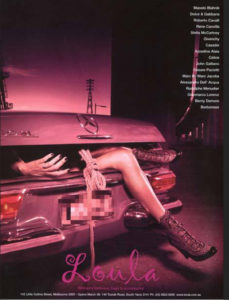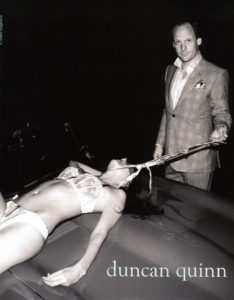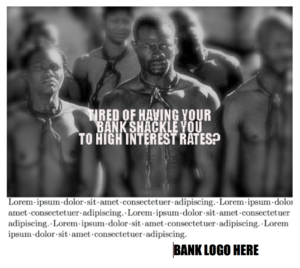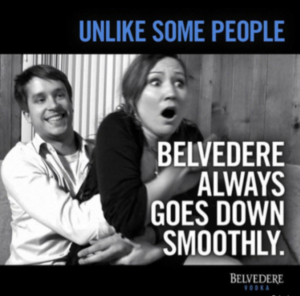Harvey Nichols is a veddy upscale British department store that holds a door-buster of a sale every year. The discrepancy between this luxury brand and its annual Wal-Mart-stampede of a sale has been the inspiration for a long-running campaign I’ve admired for years.
Recently, I used one of their ads (below) to promote a webinar I’m giving on “Leveraging Tensions to Produce Better Ideas.”

OOH for U.K.’s Harvey Nichols.
The next day, I received a text from a woman, Megan Colleen McGlynn, a colleague with whom I’ve traded emails with off and on over the years. (Her name used here with permission.) I was first struck by the civility of her tone:
MEGAN: You’ve been one of my favorites ever since I read “Hey Whipple, Squeeze This” when I was a stewardess going to school and working on my book on layovers. This is difficult for me to say, but… while I get the benefit of using conflict and tension, the example you posted looks like a woman getting beat up. I hate to think your students will be cranking out ads with images like this as an example of great advertising. I wish you’d reconsider. Sincerely, Megan
And so began this short text correspondence:
LUKE: Thanks for writing. I will clarify in next post that this image is about how high fashion store will be facing onslaught of customers at annual door-buster sale.
MEGAN: Luke, I understand the intent. But the image still shows what looks like a woman on the ground with her arms up in defense. It’s a violent trigger for anyone who’s ever been attacked. Depicting women in demeaning and violent situations in advertising is what most of us are trying to put an end to. Thanks for responding.
LUKE: Thanks, Megan. I’m gonna bring this up in classroom today as discussion.
MEGAN: Let me know what happens. The typical response I hear is a lot of “You’re being too sensitive and need to learn to take a joke.”
LUKE [Later:] Well, after lots of discussion, my students were about 60% of the opinion that the world is full enough of images of violence to women and that the ad industry probably doesn’t need to add to it. I agree with them. And with you. I’ll write later about this on heywhipple.com.
MEGAN: I’ll definitely read it.
My change of heart came during those class discussions, a day of back-and-forth with smart students some 40 years younger than I; kids who grew up in a different world than the one I did.
Because they were all ad geeks like me, the first part of the discussion was about the concept of the ad. (Most of them admired it.) But the question I pushed towards was, “Are people who are tired of images like these, or offended by them, or triggered by them…. aren’t these people being what some call ‘snowflakes’?”
 This term, dating back to the Civil War, was popularized most recently by sexual-harasser Bill O’Reilly who wrote: “We all know Snowflakes. The people who blame everyone else for their failures, who look to others to solve their problems, who are sooooo sensitive to every slight.” (Which describes – some note with interest – Donald Trump. His ineloquence was the inspiration for the title of this essay.)
This term, dating back to the Civil War, was popularized most recently by sexual-harasser Bill O’Reilly who wrote: “We all know Snowflakes. The people who blame everyone else for their failures, who look to others to solve their problems, who are sooooo sensitive to every slight.” (Which describes – some note with interest – Donald Trump. His ineloquence was the inspiration for the title of this essay.)
That was my question to spark the debate: Are people who take exception to images like this, are they snowflakes?
Many students said, “Well, the image can be offensive, if you take it out of context. I mean, it is a mannequin.”
To which I asked, “Well, you’re looking at it as an ad person. But to the average person who sees this image on the side of a passing bus, what do they see?”
And so we talked. And we reviewed many egregious examples of violence, objectification, and degradation of women in advertising; a sample of which I present here.
 One student, a woman, said, “That department store ad makes me mad, and it is offensive, not just to women who might have trauma or PTSD.” Another agreed: “It’s just more of same. It’s violence to women, commodified.”
One student, a woman, said, “That department store ad makes me mad, and it is offensive, not just to women who might have trauma or PTSD.” Another agreed: “It’s just more of same. It’s violence to women, commodified.”
What I found most interesting (if that’s the word) is all of the students had long become numb to this type of imagery.

Journalists and scholars describe this numbness as part of what constitutes a “rape culture,” a society in which treating women with violence or degradation is considered … acceptable. Many of us are in fact resigned to the idea that these images, well, they just exist. They’ve become part of the cultural visual iconography — whether we seem them in the news, in movies, or in popular culture like humor, comedy, or advertising, they just exist.
Regarding images like this in humor and advertising, New York Magazine writer, Alissa Quart, used the interesting term “ironic sexism … the objectification of women in a manner that uses mockery [and] quotation marks.” Other writers use terms like “hipster sexism,” a conceit where “ironic” use of such images somehow serves as a “distancing gesture, a belief that simply by applying quotations, questionable and even offensive material about women can be alchemically transformed.”
If irony or humor automatically makes things acceptable, I asked the class if it would be okay to ironically use an image of a black man in chains for a bank ad headlined “Tired of being shackled to high interest rates?”

A fake ad. Why would this ad never get approved, but the others did?
“Noooo, no, that’s too much.” (But why? I asked.) “Well, racism and slavery, they’re just so combustible right now.” (But what if I’m using the image as a joke or to be “disruptive.”) “No, you can’t. You just can’t.”
Of course, I agreed, we can’t. The industry seems to agree we can’t play here (with the occasional exception of tone-deaf and clueless pieces of shit like Pepsi’s recent commercial). The subject of religion also seems to be a fairly well-established no-fly zone. But why don’t these arguments apply to using images objectionable to women?
For the record, I myself have done an ironically-sexist ad. For Horst Salons, I created this outdoor board, knowing full well the subtext was “Horst can transform you from ‘Bow Wow’ (looking like a dog) to ‘Wow’.”
 I was sure some women would complain, but the simplicity of the concept delighted me and I was ready to shrug off any detractors with a “Oh, Christ, you’re being too sensitive. Get a sense of humor.”
I was sure some women would complain, but the simplicity of the concept delighted me and I was ready to shrug off any detractors with a “Oh, Christ, you’re being too sensitive. Get a sense of humor.”
Megan noted this in our text conversation above and said later she’s seen questionable work defended with “Well, that’s what advertising is supposed to do; to disrupt.” Megan also noted, sadly, that when she forwarded arguments like this at work, she was “labeled as ‘difficult’ or ‘not edgy enough,’” concluding, “It’s tough being a woman in advertising.”
(Embarrassing side note: See how I thought I had to man-splain the mannequin concept to Megan in our text conversation? She says women get that a lot. Full disclosure: I may suck.) (Second side note: Most of the terrible stuff out there would not likely have been produced if a woman had been in the room. Advertising needs women. Apply now. Operators – who are not necessarily women – are standing by.)

 As our class drew near the end, one student noted, “Well, here’s the problem. People can be offended by just about anything. What if someone’s all PTSD about car accidents? If you take all this to its logical conclusion, can you really do an ad about anything? Somebody’s going to complain.”
As our class drew near the end, one student noted, “Well, here’s the problem. People can be offended by just about anything. What if someone’s all PTSD about car accidents? If you take all this to its logical conclusion, can you really do an ad about anything? Somebody’s going to complain.”
I responded by saying this counter-argument sounds a lot like the “slippery slope” gambit commonly used by conservatives to resist any change they object to. When the marriage-equality bill was introduced in Congress, they decried, “Well, if the definition of marriage can include a man marrying a man, then why can’t a man marry a goat? Or a lawn mower?”
 Setting aside the fact that I would very much like to see those politicians stick their dicks in lawn mowers, such arguments are specious. Marriage does not include lawn mowers and thoughtful self-regulation in advertising doesn’t mean edginess is off-limits and all future advertising should be agreeable to every person on the planet.
Setting aside the fact that I would very much like to see those politicians stick their dicks in lawn mowers, such arguments are specious. Marriage does not include lawn mowers and thoughtful self-regulation in advertising doesn’t mean edginess is off-limits and all future advertising should be agreeable to every person on the planet.
We ended the class that day basically agreeing to this statement:
Given there are already so many images of abuse and degradation of women in the media, do we as advertising creatives really need to add any more to the pile?
 As an ad geek, I still admire my old Horst billboard. And I still love that Harvey Nichols mannequin poster. But since there are indeed a billion ways to solve a problem, maybe I can just push past a problematic image – however clever or elegant it may seem to me – and come up with something that doesn’t add to the pile of objectionable stuff out there.
As an ad geek, I still admire my old Horst billboard. And I still love that Harvey Nichols mannequin poster. But since there are indeed a billion ways to solve a problem, maybe I can just push past a problematic image – however clever or elegant it may seem to me – and come up with something that doesn’t add to the pile of objectionable stuff out there.
Today, thanks to that text from Megan, I fully understand what advertising CCO Madonna Badger was talking about in that speech she gave at Cannes. To paraphrase: The widespread use of violent or degrading representations of women as objects in advertising changes how society understands women. It counters the broader efforts of legislation, as well as the media and social marketing campaigns aiming to combat violence against women.
I’ll close with this.
Remember that Golden Rule thing? “Treat others how you would like to be treated.” Well, there’s the lesser-known Platinum Rule that goes “Treat others as they would like to be treated.”
Yeah, I can do that. I can be the change I want to see in the world.



 My webinar on achieving creative break-throughs airs this Thursday at 1pm EST. Pictured here, Zoom recording of pre…
My webinar on achieving creative break-throughs airs this Thursday at 1pm EST. Pictured here, Zoom recording of pre… 
Great essay Luke. Your honesty is refreshing. Frankly, that mannequin billboard would convey a trampling stampede more clearly if arranged on it’s stomach, arms apart, as if people were running over its back. I agree that is an unnecessarily violent image, and love both that Megan started the discussion and how she did it. Your back and forth dialogue was so refreshingly focused on understanding instead of namecalling. Good on you both.
For some reason I didn’t open with my usual Hey Fuckface…!
A few things:
– Goodness is good regardless of gender. Fashion ads are not good. They project shallowness.
– Ad people. You can’t be an ad person if you don’t know how your target is going to see it. Luke, you have been in the business forever, certainly you have not known this.
– “Gay” marriage. The argument you make is specious at best. Marriage is about creating a family. 2 men cannot. No different than a man and a lawnmower. And knowing you as an so-called intellectual, you would also know the US Constitution does not give the government (Federal) the power to define it. That is left to the states.
Ads should be welcoming to all and even more inviting to those targeted. Too much politics. Too much propaganda. Too much pushing agendas.
We are not NY Times “journalists” we market products and services.
Men raise families all the time. Often if not always, they add to the overall well-being of young kids they welcome into their homes and hearts, who’d otherwise possibly live in orphanage for life, if not on the streets.
There should never be an argument against that in my opinion.
Children are not pets. The examples set by same-sex “parenting” to these children set poor examples. In fact, it does a disservice to all mankind. One of the things that certainly cannot exist in such a home is God. These children will grow up without morality, be it Christian, Jewish or any other faith as this is a moral impasse where the child is burdened with defending their “parents” against God’s law.
So, there is a HUGE argument against it.
If men or women want to sin against God and nature, let it be their own. Involving the innocent is purely the work of evil.
Children raised by same-sex couples actually fare slightly better than those raised by opposite-sex couples. As for your god notions, when you can produce a shred of evidence any god exists, be sure and come back.
I guess the question should be “what is your edginess attempting to inspire?”
What is the root of supposed edge?
If it is to invoke imagery which denies or locks another’s life then it’a not edgy it is perpetuating the same narrative.
Advertising is and will always be subjective. It really comes down to who you’re target audience is for that brand. We need to realize that an ad that runs in Europe can have a completely different meaning in Asia. The problem we face here in the U.S. Is that half this country doesn’t have a sense of humor.
Luke- don’t just assume because you are a woman in advertising you won’t make ads that degrade woman. A mutual friend of ours did some ads for the Hard Rock brand and Dolce and Gabbana – were as full of innuendo as they come. Her ads for Harry Winston- were built on sex appeal. Sensitivity doesn’t come with your chromosomes.
What happens if the mannequin was a male and men who saw it felt triggered because they had been beaten up before?
Where do we draw the line here? Surely there is a middle ground
The article was a good beginning, but the issue goes far deeper and involves a lot more than just women – e.g., any use of the military, or veterans let’s say, in advertising, promotes violence and war. So even positive objectification is problematic.
A note, you were not mansplaining. How should/would you know if Megan “got” the point of the ad, or your take on it?
It’s about making sure two people in a conversation are on the same page. Nothing wrong with that, and it would go a long way to improving conversations/communications in general if more people actually did that. It’s only mansplaining if your intent was to patronize, or you felt that she (being a woman) was unable to comprehend something. You weren’t doing that. Part of dialogue is a journey of two minds in a partnership for deeper understanding. Sometimes you state the obvious just because the obvious needs to be stated.
Hi Luke. I appreciate what you are doing here.
I have mixed feelings about this topic. On the one hand, we’re in a cultural moment in which we’re collectively re-evaluating how we feel about the portrayal of others and what that indicates about our personal judgments. On the other – we are paid to win in the marketplace for our clients.
Sometimes, those two principles do not go hand in hand. We have to appeal to our target audiences. We don’t always have to like them or their ideals.
As well, I think what might be lost is the context of the times in which the ads you are referencing were made. When it was made, was the mannequin ad perceived in the same way it was perceived today by your poster? Maybe not.
I think we should be creating advertising that compels our target audiences without judging their lives or opinions. But with consideration with what we are adding to the collective conversation with our work. If we were discussing those things more openly more often, we may not always please everyone. But we’ll make purposeful decisions about what we’re adding to the collective.
So I am glad you discussed it with your class – and with us.
At the end of the day, the consumer is always in charge. Don’t like images/messages that an organization is putting out – then don’t give them money! As long as “it” continues to move the needle for clients, marketing will continue to use “it”.
Thank you Luke – this was a really great read. And it was refreshing to see the tact and respect Megan, your students, and yourself approached the subject with. Another filter for these ads should be: is this truly the best way to reach the target? I’ve always been a fan of the Harvey Nichols campaign. And yes, it’s a mannequin scared for its life. But to a non ad person driving down the freeway at 60mph it’s a billboard of a trampled woman, which may not be the best way to target women. For the other examples that are clearly sexist on purpose, I would love to know if that translates into more sales. I would bet it doesn’t. Or hope it doesn’t anyway.
Thanks again Luke –
I look forward to your next post.